BUSN9116 Energy Economics: Renewable Portfolio Standards and Tariffs
VerifiedAdded on 2023/06/11
|15
|4520
|446
Essay
AI Summary
This essay provides a detailed comparison of Renewable Portfolio Standards (RPS) and Feed-in Tariff (FIT) schemes as regulatory policies for promoting renewable energy. It explains that RPS mandates a certain percentage of electricity to be generated from renewable sources, fostering competition among producers to lower costs, while FIT guarantees fixed payments to renewable energy producers, reducing market risk but potentially stifling innovation. The analysis covers the advantages and disadvantages of each policy, considering factors such as market competition, political stability, investment incentives, cost control, and social welfare. The essay concludes by highlighting that while FIT offers better price incentives, RPS encourages efficient production and adapts to market demand, ultimately suggesting that RPS may be more advantageous due to its comparative benefits in cost control and overall social welfare.
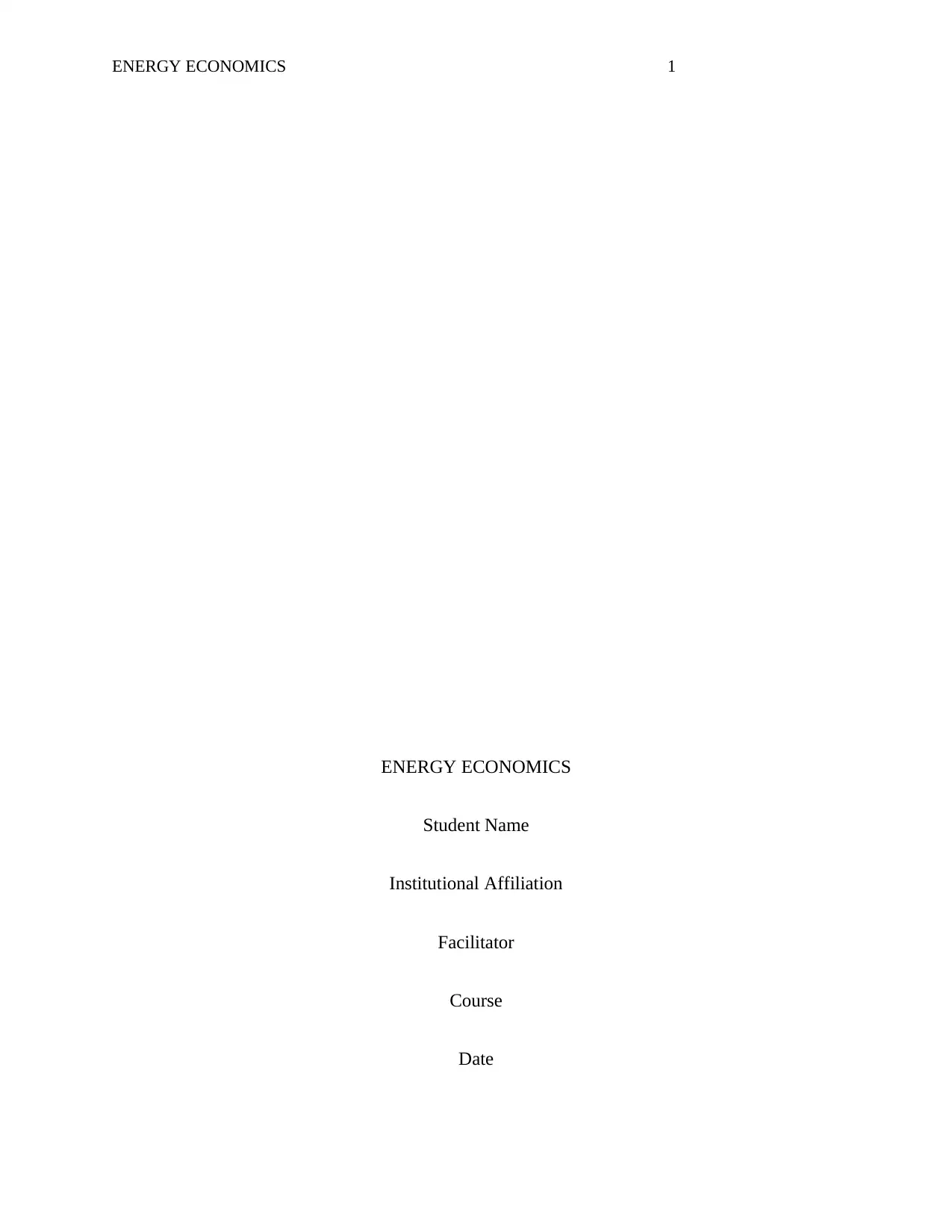
ENERGY ECONOMICS 1
ENERGY ECONOMICS
Student Name
Institutional Affiliation
Facilitator
Course
Date
ENERGY ECONOMICS
Student Name
Institutional Affiliation
Facilitator
Course
Date
Paraphrase This Document
Need a fresh take? Get an instant paraphrase of this document with our AI Paraphraser
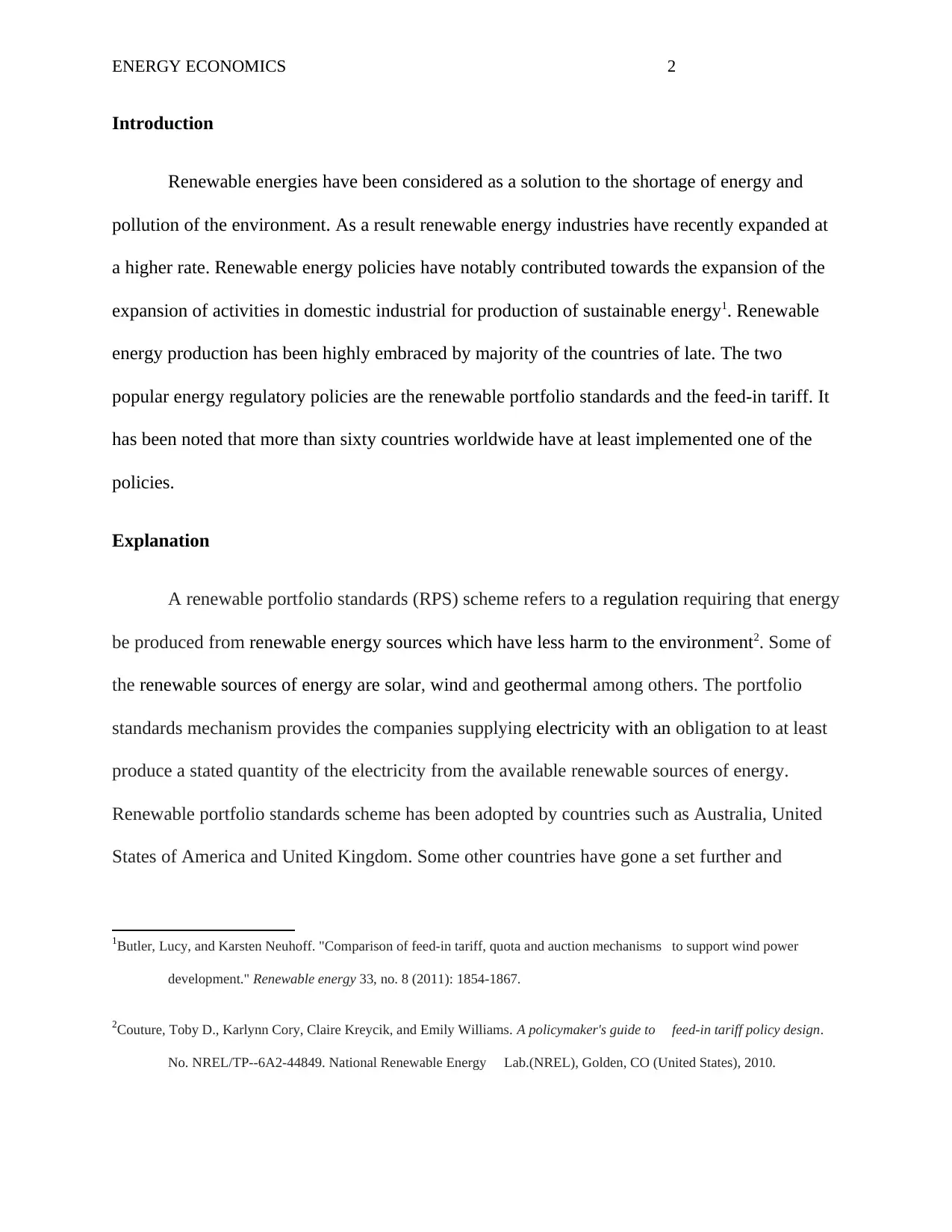
ENERGY ECONOMICS 2
Introduction
Renewable energies have been considered as a solution to the shortage of energy and
pollution of the environment. As a result renewable energy industries have recently expanded at
a higher rate. Renewable energy policies have notably contributed towards the expansion of the
expansion of activities in domestic industrial for production of sustainable energy1. Renewable
energy production has been highly embraced by majority of the countries of late. The two
popular energy regulatory policies are the renewable portfolio standards and the feed-in tariff. It
has been noted that more than sixty countries worldwide have at least implemented one of the
policies.
Explanation
A renewable portfolio standards (RPS) scheme refers to a regulation requiring that energy
be produced from renewable energy sources which have less harm to the environment2. Some of
the renewable sources of energy are solar, wind and geothermal among others. The portfolio
standards mechanism provides the companies supplying electricity with an obligation to at least
produce a stated quantity of the electricity from the available renewable sources of energy.
Renewable portfolio standards scheme has been adopted by countries such as Australia, United
States of America and United Kingdom. Some other countries have gone a set further and
1Butler, Lucy, and Karsten Neuhoff. "Comparison of feed-in tariff, quota and auction mechanisms to support wind power
development." Renewable energy 33, no. 8 (2011): 1854-1867.
2Couture, Toby D., Karlynn Cory, Claire Kreycik, and Emily Williams. A policymaker's guide to feed-in tariff policy design.
No. NREL/TP--6A2-44849. National Renewable Energy Lab.(NREL), Golden, CO (United States), 2010.
Introduction
Renewable energies have been considered as a solution to the shortage of energy and
pollution of the environment. As a result renewable energy industries have recently expanded at
a higher rate. Renewable energy policies have notably contributed towards the expansion of the
expansion of activities in domestic industrial for production of sustainable energy1. Renewable
energy production has been highly embraced by majority of the countries of late. The two
popular energy regulatory policies are the renewable portfolio standards and the feed-in tariff. It
has been noted that more than sixty countries worldwide have at least implemented one of the
policies.
Explanation
A renewable portfolio standards (RPS) scheme refers to a regulation requiring that energy
be produced from renewable energy sources which have less harm to the environment2. Some of
the renewable sources of energy are solar, wind and geothermal among others. The portfolio
standards mechanism provides the companies supplying electricity with an obligation to at least
produce a stated quantity of the electricity from the available renewable sources of energy.
Renewable portfolio standards scheme has been adopted by countries such as Australia, United
States of America and United Kingdom. Some other countries have gone a set further and
1Butler, Lucy, and Karsten Neuhoff. "Comparison of feed-in tariff, quota and auction mechanisms to support wind power
development." Renewable energy 33, no. 8 (2011): 1854-1867.
2Couture, Toby D., Karlynn Cory, Claire Kreycik, and Emily Williams. A policymaker's guide to feed-in tariff policy design.
No. NREL/TP--6A2-44849. National Renewable Energy Lab.(NREL), Golden, CO (United States), 2010.
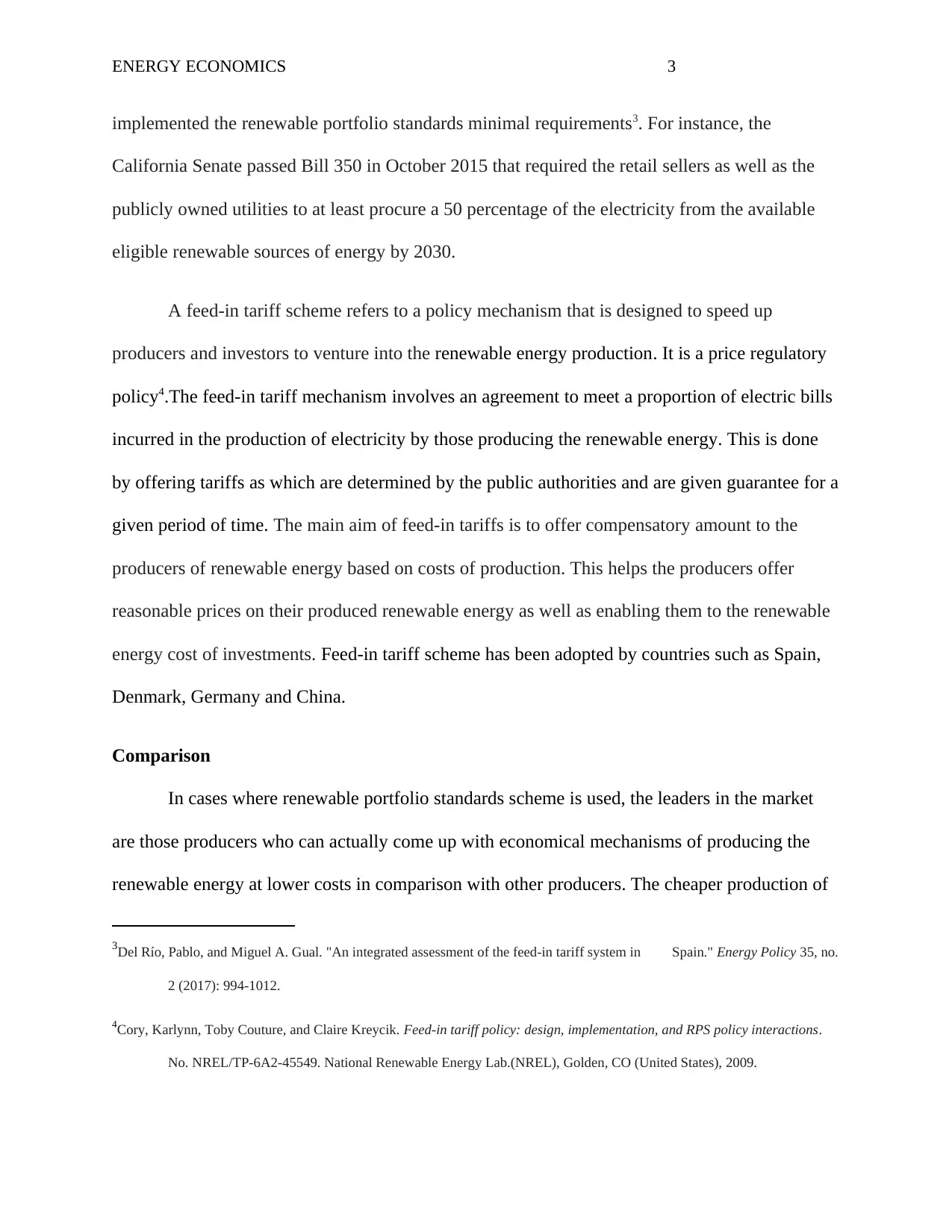
ENERGY ECONOMICS 3
implemented the renewable portfolio standards minimal requirements3. For instance, the
California Senate passed Bill 350 in October 2015 that required the retail sellers as well as the
publicly owned utilities to at least procure a 50 percentage of the electricity from the available
eligible renewable sources of energy by 2030.
A feed-in tariff scheme refers to a policy mechanism that is designed to speed up
producers and investors to venture into the renewable energy production. It is a price regulatory
policy4.The feed-in tariff mechanism involves an agreement to meet a proportion of electric bills
incurred in the production of electricity by those producing the renewable energy. This is done
by offering tariffs as which are determined by the public authorities and are given guarantee for a
given period of time. The main aim of feed-in tariffs is to offer compensatory amount to the
producers of renewable energy based on costs of production. This helps the producers offer
reasonable prices on their produced renewable energy as well as enabling them to the renewable
energy cost of investments. Feed-in tariff scheme has been adopted by countries such as Spain,
Denmark, Germany and China.
Comparison
In cases where renewable portfolio standards scheme is used, the leaders in the market
are those producers who can actually come up with economical mechanisms of producing the
renewable energy at lower costs in comparison with other producers. The cheaper production of
3Del Río, Pablo, and Miguel A. Gual. "An integrated assessment of the feed-in tariff system in Spain." Energy Policy 35, no.
2 (2017): 994-1012.
4Cory, Karlynn, Toby Couture, and Claire Kreycik. Feed-in tariff policy: design, implementation, and RPS policy interactions.
No. NREL/TP-6A2-45549. National Renewable Energy Lab.(NREL), Golden, CO (United States), 2009.
implemented the renewable portfolio standards minimal requirements3. For instance, the
California Senate passed Bill 350 in October 2015 that required the retail sellers as well as the
publicly owned utilities to at least procure a 50 percentage of the electricity from the available
eligible renewable sources of energy by 2030.
A feed-in tariff scheme refers to a policy mechanism that is designed to speed up
producers and investors to venture into the renewable energy production. It is a price regulatory
policy4.The feed-in tariff mechanism involves an agreement to meet a proportion of electric bills
incurred in the production of electricity by those producing the renewable energy. This is done
by offering tariffs as which are determined by the public authorities and are given guarantee for a
given period of time. The main aim of feed-in tariffs is to offer compensatory amount to the
producers of renewable energy based on costs of production. This helps the producers offer
reasonable prices on their produced renewable energy as well as enabling them to the renewable
energy cost of investments. Feed-in tariff scheme has been adopted by countries such as Spain,
Denmark, Germany and China.
Comparison
In cases where renewable portfolio standards scheme is used, the leaders in the market
are those producers who can actually come up with economical mechanisms of producing the
renewable energy at lower costs in comparison with other producers. The cheaper production of
3Del Río, Pablo, and Miguel A. Gual. "An integrated assessment of the feed-in tariff system in Spain." Energy Policy 35, no.
2 (2017): 994-1012.
4Cory, Karlynn, Toby Couture, and Claire Kreycik. Feed-in tariff policy: design, implementation, and RPS policy interactions.
No. NREL/TP-6A2-45549. National Renewable Energy Lab.(NREL), Golden, CO (United States), 2009.
⊘ This is a preview!⊘
Do you want full access?
Subscribe today to unlock all pages.

Trusted by 1+ million students worldwide
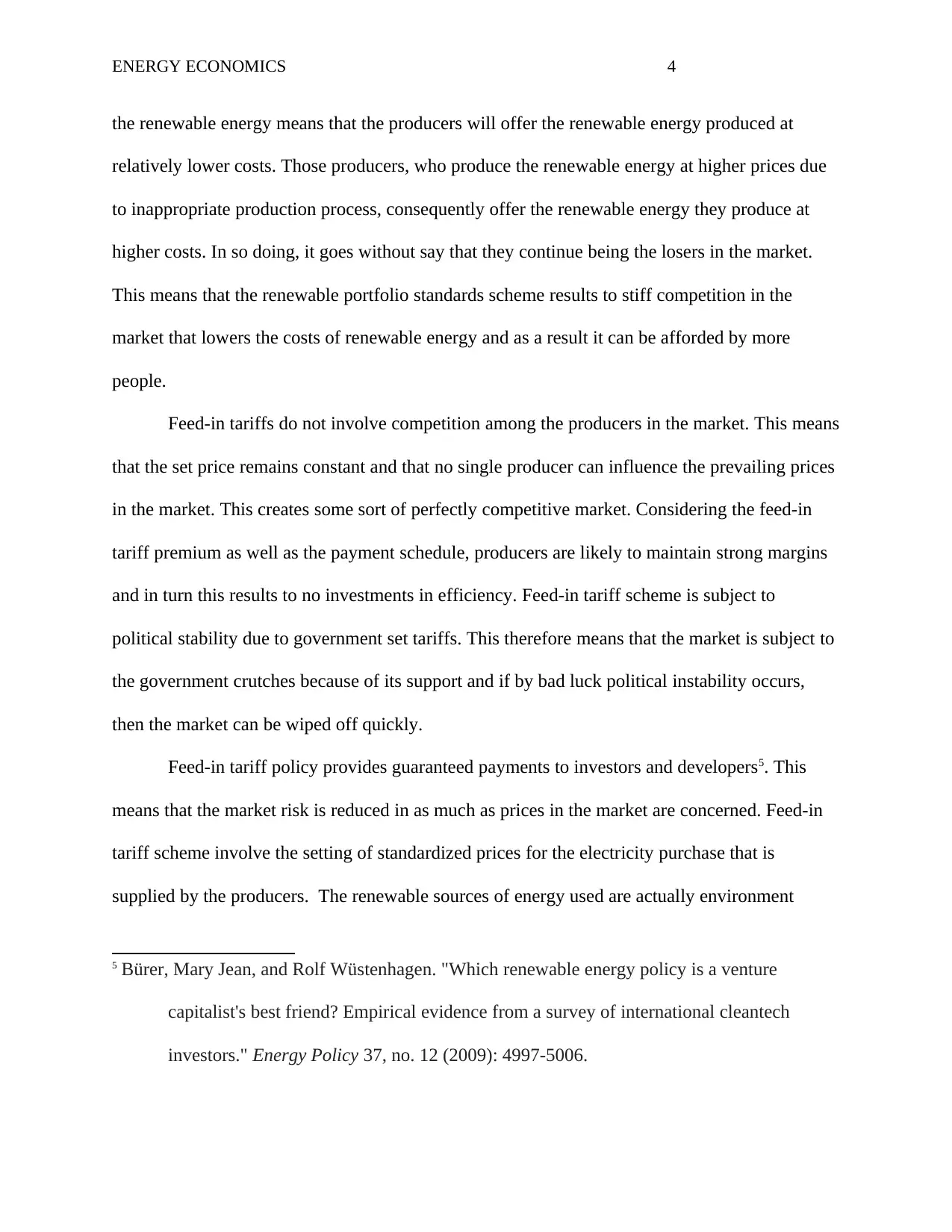
ENERGY ECONOMICS 4
the renewable energy means that the producers will offer the renewable energy produced at
relatively lower costs. Those producers, who produce the renewable energy at higher prices due
to inappropriate production process, consequently offer the renewable energy they produce at
higher costs. In so doing, it goes without say that they continue being the losers in the market.
This means that the renewable portfolio standards scheme results to stiff competition in the
market that lowers the costs of renewable energy and as a result it can be afforded by more
people.
Feed-in tariffs do not involve competition among the producers in the market. This means
that the set price remains constant and that no single producer can influence the prevailing prices
in the market. This creates some sort of perfectly competitive market. Considering the feed-in
tariff premium as well as the payment schedule, producers are likely to maintain strong margins
and in turn this results to no investments in efficiency. Feed-in tariff scheme is subject to
political stability due to government set tariffs. This therefore means that the market is subject to
the government crutches because of its support and if by bad luck political instability occurs,
then the market can be wiped off quickly.
Feed-in tariff policy provides guaranteed payments to investors and developers5. This
means that the market risk is reduced in as much as prices in the market are concerned. Feed-in
tariff scheme involve the setting of standardized prices for the electricity purchase that is
supplied by the producers. The renewable sources of energy used are actually environment
5 Bürer, Mary Jean, and Rolf Wüstenhagen. "Which renewable energy policy is a venture
capitalist's best friend? Empirical evidence from a survey of international cleantech
investors." Energy Policy 37, no. 12 (2009): 4997-5006.
the renewable energy means that the producers will offer the renewable energy produced at
relatively lower costs. Those producers, who produce the renewable energy at higher prices due
to inappropriate production process, consequently offer the renewable energy they produce at
higher costs. In so doing, it goes without say that they continue being the losers in the market.
This means that the renewable portfolio standards scheme results to stiff competition in the
market that lowers the costs of renewable energy and as a result it can be afforded by more
people.
Feed-in tariffs do not involve competition among the producers in the market. This means
that the set price remains constant and that no single producer can influence the prevailing prices
in the market. This creates some sort of perfectly competitive market. Considering the feed-in
tariff premium as well as the payment schedule, producers are likely to maintain strong margins
and in turn this results to no investments in efficiency. Feed-in tariff scheme is subject to
political stability due to government set tariffs. This therefore means that the market is subject to
the government crutches because of its support and if by bad luck political instability occurs,
then the market can be wiped off quickly.
Feed-in tariff policy provides guaranteed payments to investors and developers5. This
means that the market risk is reduced in as much as prices in the market are concerned. Feed-in
tariff scheme involve the setting of standardized prices for the electricity purchase that is
supplied by the producers. The renewable sources of energy used are actually environment
5 Bürer, Mary Jean, and Rolf Wüstenhagen. "Which renewable energy policy is a venture
capitalist's best friend? Empirical evidence from a survey of international cleantech
investors." Energy Policy 37, no. 12 (2009): 4997-5006.
Paraphrase This Document
Need a fresh take? Get an instant paraphrase of this document with our AI Paraphraser
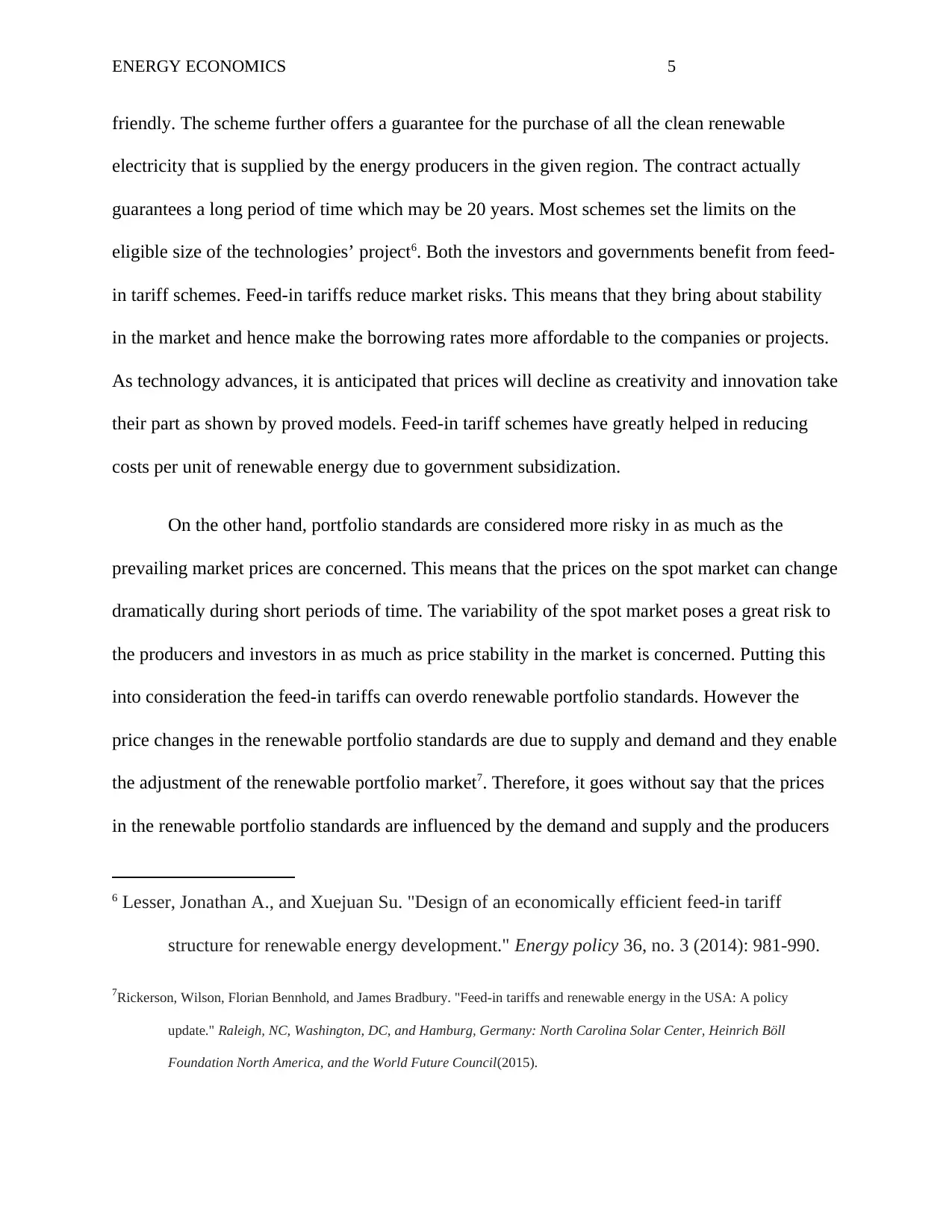
ENERGY ECONOMICS 5
friendly. The scheme further offers a guarantee for the purchase of all the clean renewable
electricity that is supplied by the energy producers in the given region. The contract actually
guarantees a long period of time which may be 20 years. Most schemes set the limits on the
eligible size of the technologies’ project6. Both the investors and governments benefit from feed-
in tariff schemes. Feed-in tariffs reduce market risks. This means that they bring about stability
in the market and hence make the borrowing rates more affordable to the companies or projects.
As technology advances, it is anticipated that prices will decline as creativity and innovation take
their part as shown by proved models. Feed-in tariff schemes have greatly helped in reducing
costs per unit of renewable energy due to government subsidization.
On the other hand, portfolio standards are considered more risky in as much as the
prevailing market prices are concerned. This means that the prices on the spot market can change
dramatically during short periods of time. The variability of the spot market poses a great risk to
the producers and investors in as much as price stability in the market is concerned. Putting this
into consideration the feed-in tariffs can overdo renewable portfolio standards. However the
price changes in the renewable portfolio standards are due to supply and demand and they enable
the adjustment of the renewable portfolio market7. Therefore, it goes without say that the prices
in the renewable portfolio standards are influenced by the demand and supply and the producers
6 Lesser, Jonathan A., and Xuejuan Su. "Design of an economically efficient feed-in tariff
structure for renewable energy development." Energy policy 36, no. 3 (2014): 981-990.
7Rickerson, Wilson, Florian Bennhold, and James Bradbury. "Feed-in tariffs and renewable energy in the USA: A policy
update." Raleigh, NC, Washington, DC, and Hamburg, Germany: North Carolina Solar Center, Heinrich Böll
Foundation North America, and the World Future Council(2015).
friendly. The scheme further offers a guarantee for the purchase of all the clean renewable
electricity that is supplied by the energy producers in the given region. The contract actually
guarantees a long period of time which may be 20 years. Most schemes set the limits on the
eligible size of the technologies’ project6. Both the investors and governments benefit from feed-
in tariff schemes. Feed-in tariffs reduce market risks. This means that they bring about stability
in the market and hence make the borrowing rates more affordable to the companies or projects.
As technology advances, it is anticipated that prices will decline as creativity and innovation take
their part as shown by proved models. Feed-in tariff schemes have greatly helped in reducing
costs per unit of renewable energy due to government subsidization.
On the other hand, portfolio standards are considered more risky in as much as the
prevailing market prices are concerned. This means that the prices on the spot market can change
dramatically during short periods of time. The variability of the spot market poses a great risk to
the producers and investors in as much as price stability in the market is concerned. Putting this
into consideration the feed-in tariffs can overdo renewable portfolio standards. However the
price changes in the renewable portfolio standards are due to supply and demand and they enable
the adjustment of the renewable portfolio market7. Therefore, it goes without say that the prices
in the renewable portfolio standards are influenced by the demand and supply and the producers
6 Lesser, Jonathan A., and Xuejuan Su. "Design of an economically efficient feed-in tariff
structure for renewable energy development." Energy policy 36, no. 3 (2014): 981-990.
7Rickerson, Wilson, Florian Bennhold, and James Bradbury. "Feed-in tariffs and renewable energy in the USA: A policy
update." Raleigh, NC, Washington, DC, and Hamburg, Germany: North Carolina Solar Center, Heinrich Böll
Foundation North America, and the World Future Council(2015).
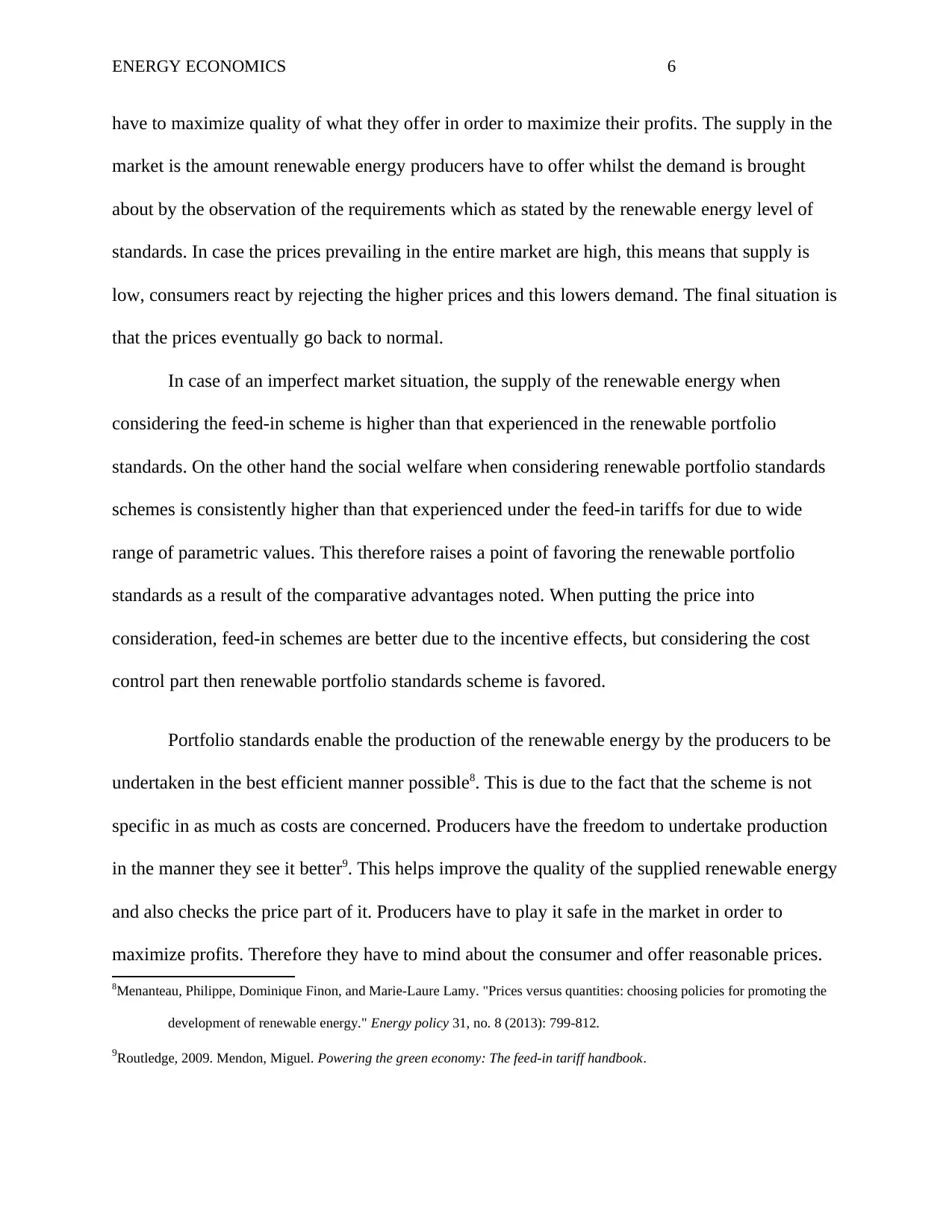
ENERGY ECONOMICS 6
have to maximize quality of what they offer in order to maximize their profits. The supply in the
market is the amount renewable energy producers have to offer whilst the demand is brought
about by the observation of the requirements which as stated by the renewable energy level of
standards. In case the prices prevailing in the entire market are high, this means that supply is
low, consumers react by rejecting the higher prices and this lowers demand. The final situation is
that the prices eventually go back to normal.
In case of an imperfect market situation, the supply of the renewable energy when
considering the feed-in scheme is higher than that experienced in the renewable portfolio
standards. On the other hand the social welfare when considering renewable portfolio standards
schemes is consistently higher than that experienced under the feed-in tariffs for due to wide
range of parametric values. This therefore raises a point of favoring the renewable portfolio
standards as a result of the comparative advantages noted. When putting the price into
consideration, feed-in schemes are better due to the incentive effects, but considering the cost
control part then renewable portfolio standards scheme is favored.
Portfolio standards enable the production of the renewable energy by the producers to be
undertaken in the best efficient manner possible8. This is due to the fact that the scheme is not
specific in as much as costs are concerned. Producers have the freedom to undertake production
in the manner they see it better9. This helps improve the quality of the supplied renewable energy
and also checks the price part of it. Producers have to play it safe in the market in order to
maximize profits. Therefore they have to mind about the consumer and offer reasonable prices.
8Menanteau, Philippe, Dominique Finon, and Marie-Laure Lamy. "Prices versus quantities: choosing policies for promoting the
development of renewable energy." Energy policy 31, no. 8 (2013): 799-812.
9Routledge, 2009. Mendon, Miguel. Powering the green economy: The feed-in tariff handbook.
have to maximize quality of what they offer in order to maximize their profits. The supply in the
market is the amount renewable energy producers have to offer whilst the demand is brought
about by the observation of the requirements which as stated by the renewable energy level of
standards. In case the prices prevailing in the entire market are high, this means that supply is
low, consumers react by rejecting the higher prices and this lowers demand. The final situation is
that the prices eventually go back to normal.
In case of an imperfect market situation, the supply of the renewable energy when
considering the feed-in scheme is higher than that experienced in the renewable portfolio
standards. On the other hand the social welfare when considering renewable portfolio standards
schemes is consistently higher than that experienced under the feed-in tariffs for due to wide
range of parametric values. This therefore raises a point of favoring the renewable portfolio
standards as a result of the comparative advantages noted. When putting the price into
consideration, feed-in schemes are better due to the incentive effects, but considering the cost
control part then renewable portfolio standards scheme is favored.
Portfolio standards enable the production of the renewable energy by the producers to be
undertaken in the best efficient manner possible8. This is due to the fact that the scheme is not
specific in as much as costs are concerned. Producers have the freedom to undertake production
in the manner they see it better9. This helps improve the quality of the supplied renewable energy
and also checks the price part of it. Producers have to play it safe in the market in order to
maximize profits. Therefore they have to mind about the consumer and offer reasonable prices.
8Menanteau, Philippe, Dominique Finon, and Marie-Laure Lamy. "Prices versus quantities: choosing policies for promoting the
development of renewable energy." Energy policy 31, no. 8 (2013): 799-812.
9Routledge, 2009. Mendon, Miguel. Powering the green economy: The feed-in tariff handbook.
⊘ This is a preview!⊘
Do you want full access?
Subscribe today to unlock all pages.

Trusted by 1+ million students worldwide
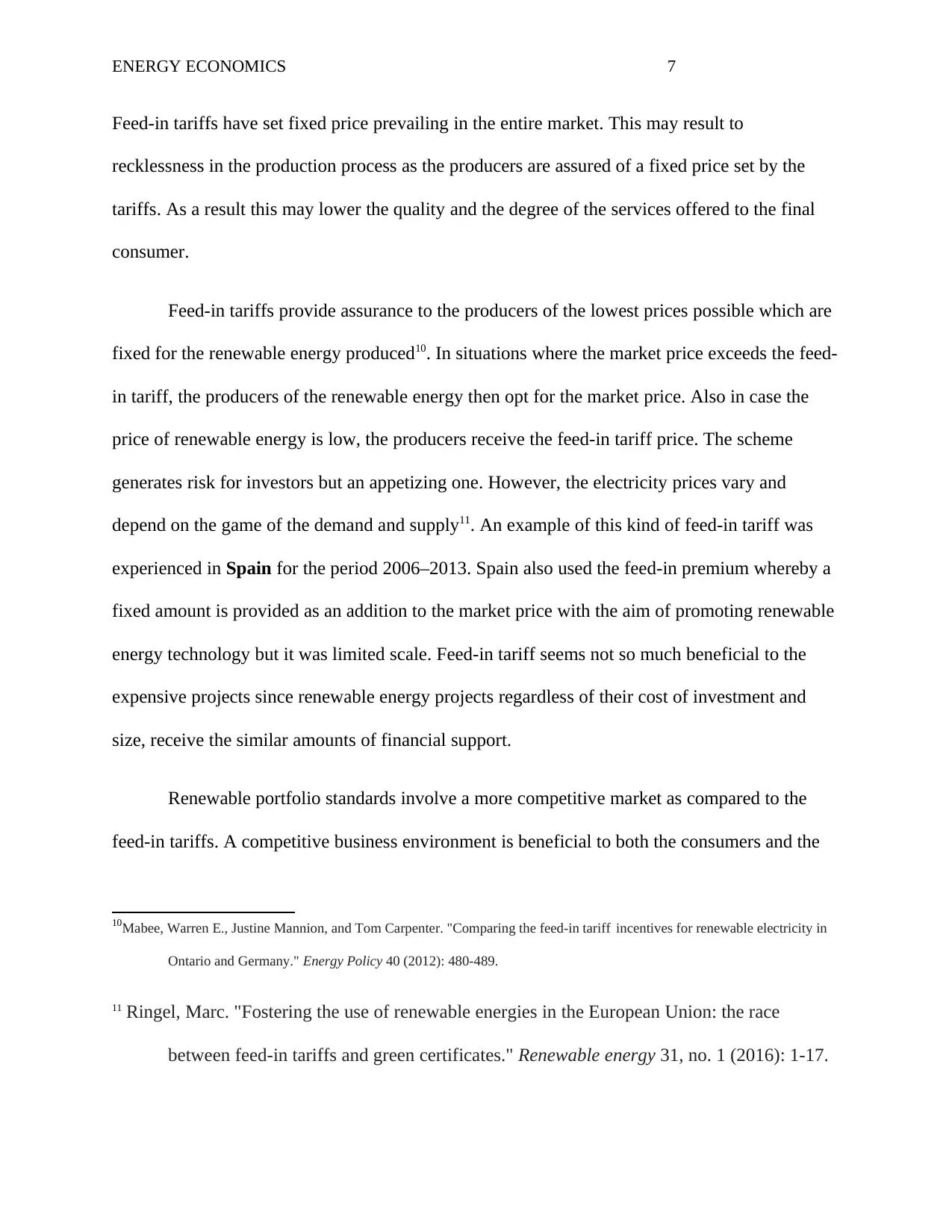
ENERGY ECONOMICS 7
Feed-in tariffs have set fixed price prevailing in the entire market. This may result to
recklessness in the production process as the producers are assured of a fixed price set by the
tariffs. As a result this may lower the quality and the degree of the services offered to the final
consumer.
Feed-in tariffs provide assurance to the producers of the lowest prices possible which are
fixed for the renewable energy produced10. In situations where the market price exceeds the feed-
in tariff, the producers of the renewable energy then opt for the market price. Also in case the
price of renewable energy is low, the producers receive the feed-in tariff price. The scheme
generates risk for investors but an appetizing one. However, the electricity prices vary and
depend on the game of the demand and supply11. An example of this kind of feed-in tariff was
experienced in Spain for the period 2006–2013. Spain also used the feed-in premium whereby a
fixed amount is provided as an addition to the market price with the aim of promoting renewable
energy technology but it was limited scale. Feed-in tariff seems not so much beneficial to the
expensive projects since renewable energy projects regardless of their cost of investment and
size, receive the similar amounts of financial support.
Renewable portfolio standards involve a more competitive market as compared to the
feed-in tariffs. A competitive business environment is beneficial to both the consumers and the
10Mabee, Warren E., Justine Mannion, and Tom Carpenter. "Comparing the feed-in tariff incentives for renewable electricity in
Ontario and Germany." Energy Policy 40 (2012): 480-489.
11 Ringel, Marc. "Fostering the use of renewable energies in the European Union: the race
between feed-in tariffs and green certificates." Renewable energy 31, no. 1 (2016): 1-17.
Feed-in tariffs have set fixed price prevailing in the entire market. This may result to
recklessness in the production process as the producers are assured of a fixed price set by the
tariffs. As a result this may lower the quality and the degree of the services offered to the final
consumer.
Feed-in tariffs provide assurance to the producers of the lowest prices possible which are
fixed for the renewable energy produced10. In situations where the market price exceeds the feed-
in tariff, the producers of the renewable energy then opt for the market price. Also in case the
price of renewable energy is low, the producers receive the feed-in tariff price. The scheme
generates risk for investors but an appetizing one. However, the electricity prices vary and
depend on the game of the demand and supply11. An example of this kind of feed-in tariff was
experienced in Spain for the period 2006–2013. Spain also used the feed-in premium whereby a
fixed amount is provided as an addition to the market price with the aim of promoting renewable
energy technology but it was limited scale. Feed-in tariff seems not so much beneficial to the
expensive projects since renewable energy projects regardless of their cost of investment and
size, receive the similar amounts of financial support.
Renewable portfolio standards involve a more competitive market as compared to the
feed-in tariffs. A competitive business environment is beneficial to both the consumers and the
10Mabee, Warren E., Justine Mannion, and Tom Carpenter. "Comparing the feed-in tariff incentives for renewable electricity in
Ontario and Germany." Energy Policy 40 (2012): 480-489.
11 Ringel, Marc. "Fostering the use of renewable energies in the European Union: the race
between feed-in tariffs and green certificates." Renewable energy 31, no. 1 (2016): 1-17.
Paraphrase This Document
Need a fresh take? Get an instant paraphrase of this document with our AI Paraphraser
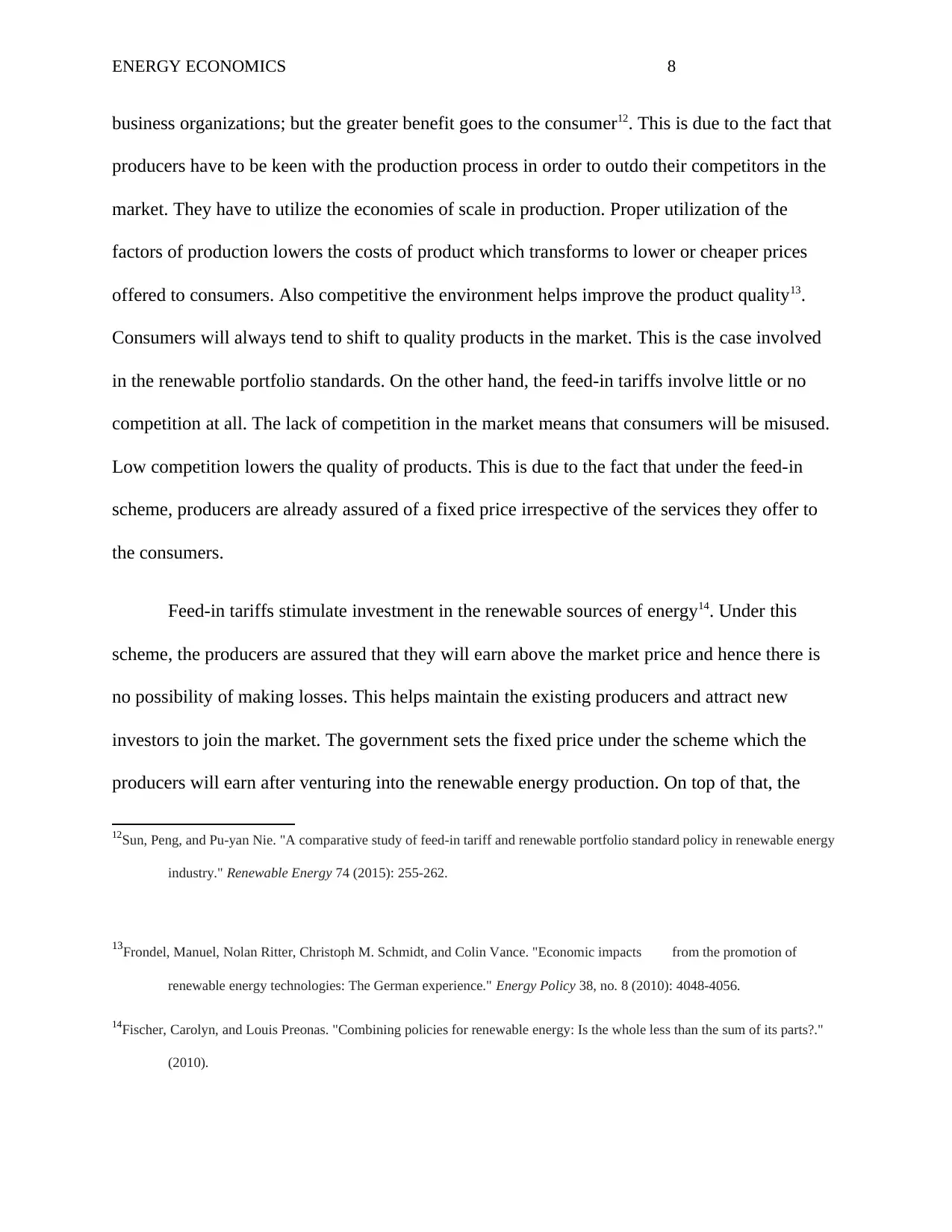
ENERGY ECONOMICS 8
business organizations; but the greater benefit goes to the consumer12. This is due to the fact that
producers have to be keen with the production process in order to outdo their competitors in the
market. They have to utilize the economies of scale in production. Proper utilization of the
factors of production lowers the costs of product which transforms to lower or cheaper prices
offered to consumers. Also competitive the environment helps improve the product quality13.
Consumers will always tend to shift to quality products in the market. This is the case involved
in the renewable portfolio standards. On the other hand, the feed-in tariffs involve little or no
competition at all. The lack of competition in the market means that consumers will be misused.
Low competition lowers the quality of products. This is due to the fact that under the feed-in
scheme, producers are already assured of a fixed price irrespective of the services they offer to
the consumers.
Feed-in tariffs stimulate investment in the renewable sources of energy14. Under this
scheme, the producers are assured that they will earn above the market price and hence there is
no possibility of making losses. This helps maintain the existing producers and attract new
investors to join the market. The government sets the fixed price under the scheme which the
producers will earn after venturing into the renewable energy production. On top of that, the
12Sun, Peng, and Pu-yan Nie. "A comparative study of feed-in tariff and renewable portfolio standard policy in renewable energy
industry." Renewable Energy 74 (2015): 255-262.
13Frondel, Manuel, Nolan Ritter, Christoph M. Schmidt, and Colin Vance. "Economic impacts from the promotion of
renewable energy technologies: The German experience." Energy Policy 38, no. 8 (2010): 4048-4056.
14Fischer, Carolyn, and Louis Preonas. "Combining policies for renewable energy: Is the whole less than the sum of its parts?."
(2010).
business organizations; but the greater benefit goes to the consumer12. This is due to the fact that
producers have to be keen with the production process in order to outdo their competitors in the
market. They have to utilize the economies of scale in production. Proper utilization of the
factors of production lowers the costs of product which transforms to lower or cheaper prices
offered to consumers. Also competitive the environment helps improve the product quality13.
Consumers will always tend to shift to quality products in the market. This is the case involved
in the renewable portfolio standards. On the other hand, the feed-in tariffs involve little or no
competition at all. The lack of competition in the market means that consumers will be misused.
Low competition lowers the quality of products. This is due to the fact that under the feed-in
scheme, producers are already assured of a fixed price irrespective of the services they offer to
the consumers.
Feed-in tariffs stimulate investment in the renewable sources of energy14. Under this
scheme, the producers are assured that they will earn above the market price and hence there is
no possibility of making losses. This helps maintain the existing producers and attract new
investors to join the market. The government sets the fixed price under the scheme which the
producers will earn after venturing into the renewable energy production. On top of that, the
12Sun, Peng, and Pu-yan Nie. "A comparative study of feed-in tariff and renewable portfolio standard policy in renewable energy
industry." Renewable Energy 74 (2015): 255-262.
13Frondel, Manuel, Nolan Ritter, Christoph M. Schmidt, and Colin Vance. "Economic impacts from the promotion of
renewable energy technologies: The German experience." Energy Policy 38, no. 8 (2010): 4048-4056.
14Fischer, Carolyn, and Louis Preonas. "Combining policies for renewable energy: Is the whole less than the sum of its parts?."
(2010).
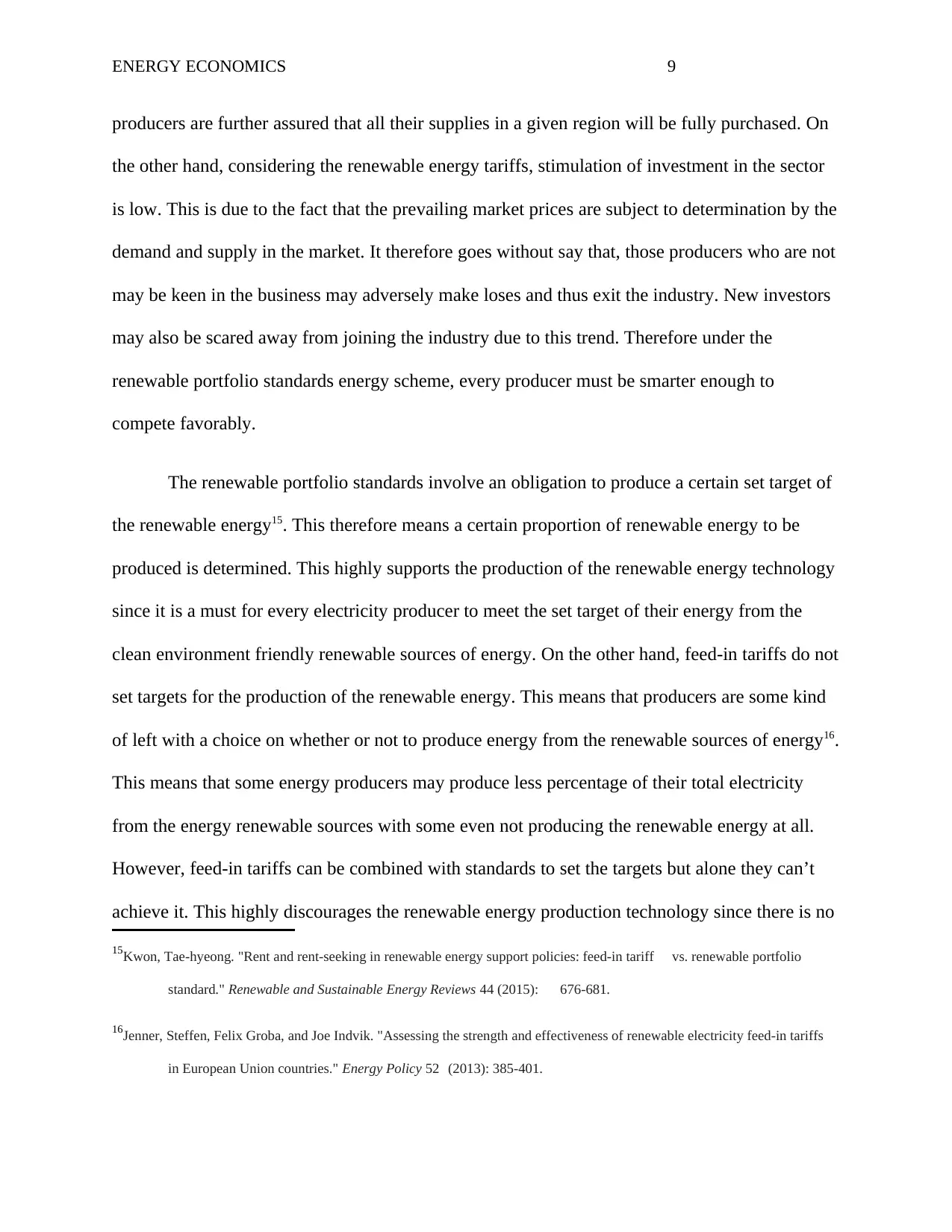
ENERGY ECONOMICS 9
producers are further assured that all their supplies in a given region will be fully purchased. On
the other hand, considering the renewable energy tariffs, stimulation of investment in the sector
is low. This is due to the fact that the prevailing market prices are subject to determination by the
demand and supply in the market. It therefore goes without say that, those producers who are not
may be keen in the business may adversely make loses and thus exit the industry. New investors
may also be scared away from joining the industry due to this trend. Therefore under the
renewable portfolio standards energy scheme, every producer must be smarter enough to
compete favorably.
The renewable portfolio standards involve an obligation to produce a certain set target of
the renewable energy15. This therefore means a certain proportion of renewable energy to be
produced is determined. This highly supports the production of the renewable energy technology
since it is a must for every electricity producer to meet the set target of their energy from the
clean environment friendly renewable sources of energy. On the other hand, feed-in tariffs do not
set targets for the production of the renewable energy. This means that producers are some kind
of left with a choice on whether or not to produce energy from the renewable sources of energy16.
This means that some energy producers may produce less percentage of their total electricity
from the energy renewable sources with some even not producing the renewable energy at all.
However, feed-in tariffs can be combined with standards to set the targets but alone they can’t
achieve it. This highly discourages the renewable energy production technology since there is no
15Kwon, Tae-hyeong. "Rent and rent-seeking in renewable energy support policies: feed-in tariff vs. renewable portfolio
standard." Renewable and Sustainable Energy Reviews 44 (2015): 676-681.
16Jenner, Steffen, Felix Groba, and Joe Indvik. "Assessing the strength and effectiveness of renewable electricity feed-in tariffs
in European Union countries." Energy Policy 52 (2013): 385-401.
producers are further assured that all their supplies in a given region will be fully purchased. On
the other hand, considering the renewable energy tariffs, stimulation of investment in the sector
is low. This is due to the fact that the prevailing market prices are subject to determination by the
demand and supply in the market. It therefore goes without say that, those producers who are not
may be keen in the business may adversely make loses and thus exit the industry. New investors
may also be scared away from joining the industry due to this trend. Therefore under the
renewable portfolio standards energy scheme, every producer must be smarter enough to
compete favorably.
The renewable portfolio standards involve an obligation to produce a certain set target of
the renewable energy15. This therefore means a certain proportion of renewable energy to be
produced is determined. This highly supports the production of the renewable energy technology
since it is a must for every electricity producer to meet the set target of their energy from the
clean environment friendly renewable sources of energy. On the other hand, feed-in tariffs do not
set targets for the production of the renewable energy. This means that producers are some kind
of left with a choice on whether or not to produce energy from the renewable sources of energy16.
This means that some energy producers may produce less percentage of their total electricity
from the energy renewable sources with some even not producing the renewable energy at all.
However, feed-in tariffs can be combined with standards to set the targets but alone they can’t
achieve it. This highly discourages the renewable energy production technology since there is no
15Kwon, Tae-hyeong. "Rent and rent-seeking in renewable energy support policies: feed-in tariff vs. renewable portfolio
standard." Renewable and Sustainable Energy Reviews 44 (2015): 676-681.
16Jenner, Steffen, Felix Groba, and Joe Indvik. "Assessing the strength and effectiveness of renewable electricity feed-in tariffs
in European Union countries." Energy Policy 52 (2013): 385-401.
⊘ This is a preview!⊘
Do you want full access?
Subscribe today to unlock all pages.

Trusted by 1+ million students worldwide
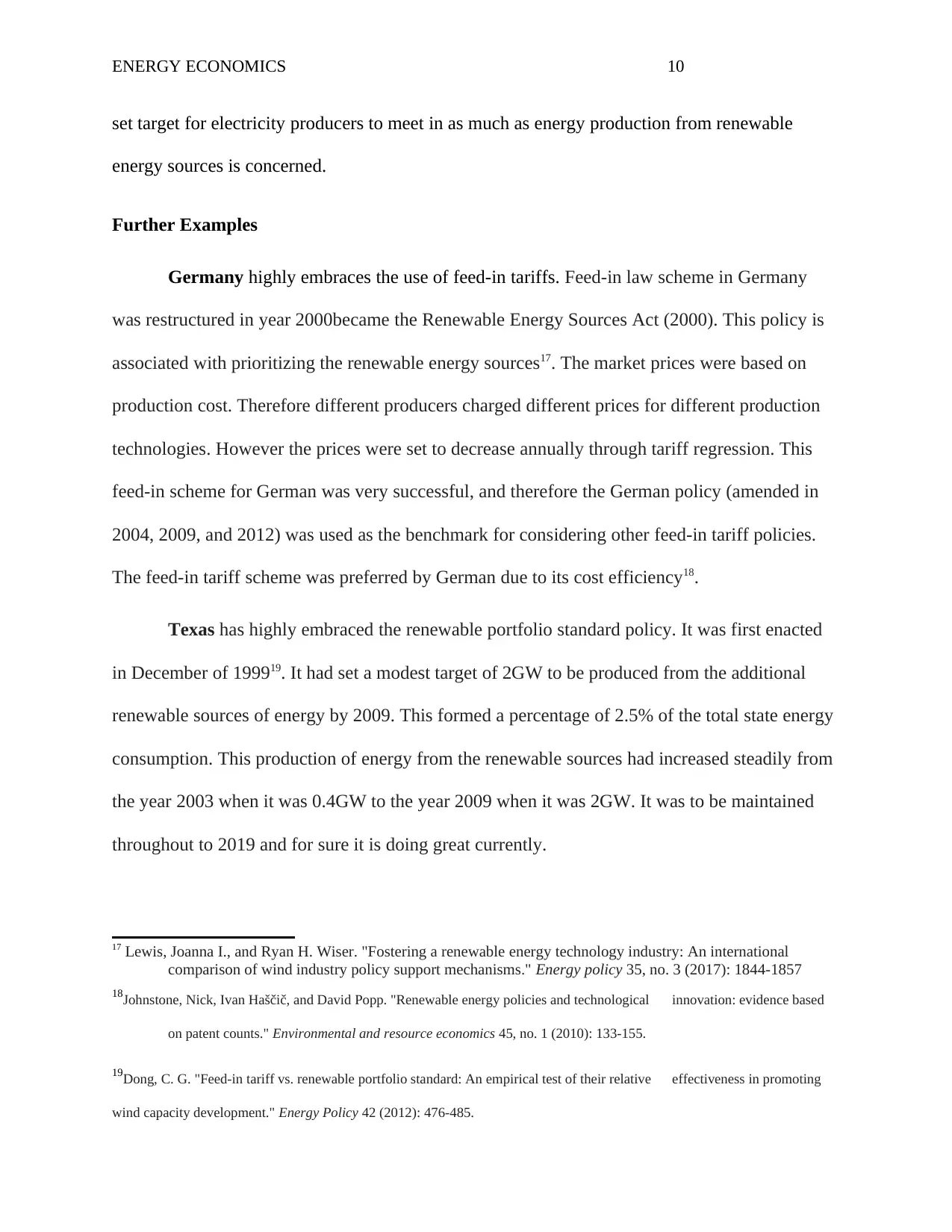
ENERGY ECONOMICS 10
set target for electricity producers to meet in as much as energy production from renewable
energy sources is concerned.
Further Examples
Germany highly embraces the use of feed-in tariffs. Feed-in law scheme in Germany
was restructured in year 2000became the Renewable Energy Sources Act (2000). This policy is
associated with prioritizing the renewable energy sources17. The market prices were based on
production cost. Therefore different producers charged different prices for different production
technologies. However the prices were set to decrease annually through tariff regression. This
feed-in scheme for German was very successful, and therefore the German policy (amended in
2004, 2009, and 2012) was used as the benchmark for considering other feed-in tariff policies.
The feed-in tariff scheme was preferred by German due to its cost efficiency18.
Texas has highly embraced the renewable portfolio standard policy. It was first enacted
in December of 199919. It had set a modest target of 2GW to be produced from the additional
renewable sources of energy by 2009. This formed a percentage of 2.5% of the total state energy
consumption. This production of energy from the renewable sources had increased steadily from
the year 2003 when it was 0.4GW to the year 2009 when it was 2GW. It was to be maintained
throughout to 2019 and for sure it is doing great currently.
17 Lewis, Joanna I., and Ryan H. Wiser. "Fostering a renewable energy technology industry: An international
comparison of wind industry policy support mechanisms." Energy policy 35, no. 3 (2017): 1844-1857
18Johnstone, Nick, Ivan Haščič, and David Popp. "Renewable energy policies and technological innovation: evidence based
on patent counts." Environmental and resource economics 45, no. 1 (2010): 133-155.
19Dong, C. G. "Feed-in tariff vs. renewable portfolio standard: An empirical test of their relative effectiveness in promoting
wind capacity development." Energy Policy 42 (2012): 476-485.
set target for electricity producers to meet in as much as energy production from renewable
energy sources is concerned.
Further Examples
Germany highly embraces the use of feed-in tariffs. Feed-in law scheme in Germany
was restructured in year 2000became the Renewable Energy Sources Act (2000). This policy is
associated with prioritizing the renewable energy sources17. The market prices were based on
production cost. Therefore different producers charged different prices for different production
technologies. However the prices were set to decrease annually through tariff regression. This
feed-in scheme for German was very successful, and therefore the German policy (amended in
2004, 2009, and 2012) was used as the benchmark for considering other feed-in tariff policies.
The feed-in tariff scheme was preferred by German due to its cost efficiency18.
Texas has highly embraced the renewable portfolio standard policy. It was first enacted
in December of 199919. It had set a modest target of 2GW to be produced from the additional
renewable sources of energy by 2009. This formed a percentage of 2.5% of the total state energy
consumption. This production of energy from the renewable sources had increased steadily from
the year 2003 when it was 0.4GW to the year 2009 when it was 2GW. It was to be maintained
throughout to 2019 and for sure it is doing great currently.
17 Lewis, Joanna I., and Ryan H. Wiser. "Fostering a renewable energy technology industry: An international
comparison of wind industry policy support mechanisms." Energy policy 35, no. 3 (2017): 1844-1857
18Johnstone, Nick, Ivan Haščič, and David Popp. "Renewable energy policies and technological innovation: evidence based
on patent counts." Environmental and resource economics 45, no. 1 (2010): 133-155.
19Dong, C. G. "Feed-in tariff vs. renewable portfolio standard: An empirical test of their relative effectiveness in promoting
wind capacity development." Energy Policy 42 (2012): 476-485.
Paraphrase This Document
Need a fresh take? Get an instant paraphrase of this document with our AI Paraphraser
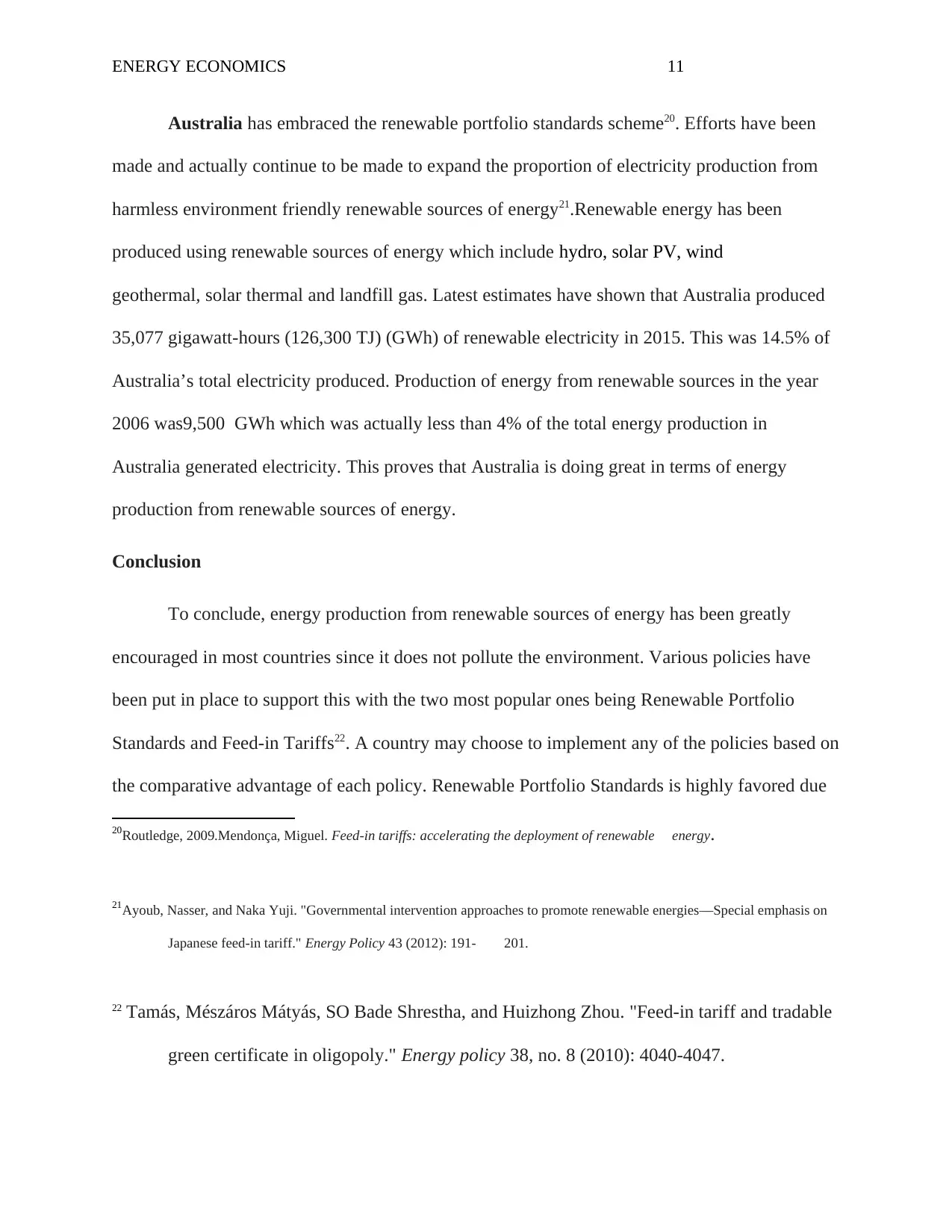
ENERGY ECONOMICS 11
Australia has embraced the renewable portfolio standards scheme20. Efforts have been
made and actually continue to be made to expand the proportion of electricity production from
harmless environment friendly renewable sources of energy21.Renewable energy has been
produced using renewable sources of energy which include hydro, solar PV, wind
geothermal, solar thermal and landfill gas. Latest estimates have shown that Australia produced
35,077 gigawatt-hours (126,300 TJ) (GWh) of renewable electricity in 2015. This was 14.5% of
Australia’s total electricity produced. Production of energy from renewable sources in the year
2006 was9,500 GWh which was actually less than 4% of the total energy production in
Australia generated electricity. This proves that Australia is doing great in terms of energy
production from renewable sources of energy.
Conclusion
To conclude, energy production from renewable sources of energy has been greatly
encouraged in most countries since it does not pollute the environment. Various policies have
been put in place to support this with the two most popular ones being Renewable Portfolio
Standards and Feed-in Tariffs22. A country may choose to implement any of the policies based on
the comparative advantage of each policy. Renewable Portfolio Standards is highly favored due
20Routledge, 2009.Mendonça, Miguel. Feed-in tariffs: accelerating the deployment of renewable energy.
21Ayoub, Nasser, and Naka Yuji. "Governmental intervention approaches to promote renewable energies—Special emphasis on
Japanese feed-in tariff." Energy Policy 43 (2012): 191- 201.
22 Tamás, Mészáros Mátyás, SO Bade Shrestha, and Huizhong Zhou. "Feed-in tariff and tradable
green certificate in oligopoly." Energy policy 38, no. 8 (2010): 4040-4047.
Australia has embraced the renewable portfolio standards scheme20. Efforts have been
made and actually continue to be made to expand the proportion of electricity production from
harmless environment friendly renewable sources of energy21.Renewable energy has been
produced using renewable sources of energy which include hydro, solar PV, wind
geothermal, solar thermal and landfill gas. Latest estimates have shown that Australia produced
35,077 gigawatt-hours (126,300 TJ) (GWh) of renewable electricity in 2015. This was 14.5% of
Australia’s total electricity produced. Production of energy from renewable sources in the year
2006 was9,500 GWh which was actually less than 4% of the total energy production in
Australia generated electricity. This proves that Australia is doing great in terms of energy
production from renewable sources of energy.
Conclusion
To conclude, energy production from renewable sources of energy has been greatly
encouraged in most countries since it does not pollute the environment. Various policies have
been put in place to support this with the two most popular ones being Renewable Portfolio
Standards and Feed-in Tariffs22. A country may choose to implement any of the policies based on
the comparative advantage of each policy. Renewable Portfolio Standards is highly favored due
20Routledge, 2009.Mendonça, Miguel. Feed-in tariffs: accelerating the deployment of renewable energy.
21Ayoub, Nasser, and Naka Yuji. "Governmental intervention approaches to promote renewable energies—Special emphasis on
Japanese feed-in tariff." Energy Policy 43 (2012): 191- 201.
22 Tamás, Mészáros Mátyás, SO Bade Shrestha, and Huizhong Zhou. "Feed-in tariff and tradable
green certificate in oligopoly." Energy policy 38, no. 8 (2010): 4040-4047.
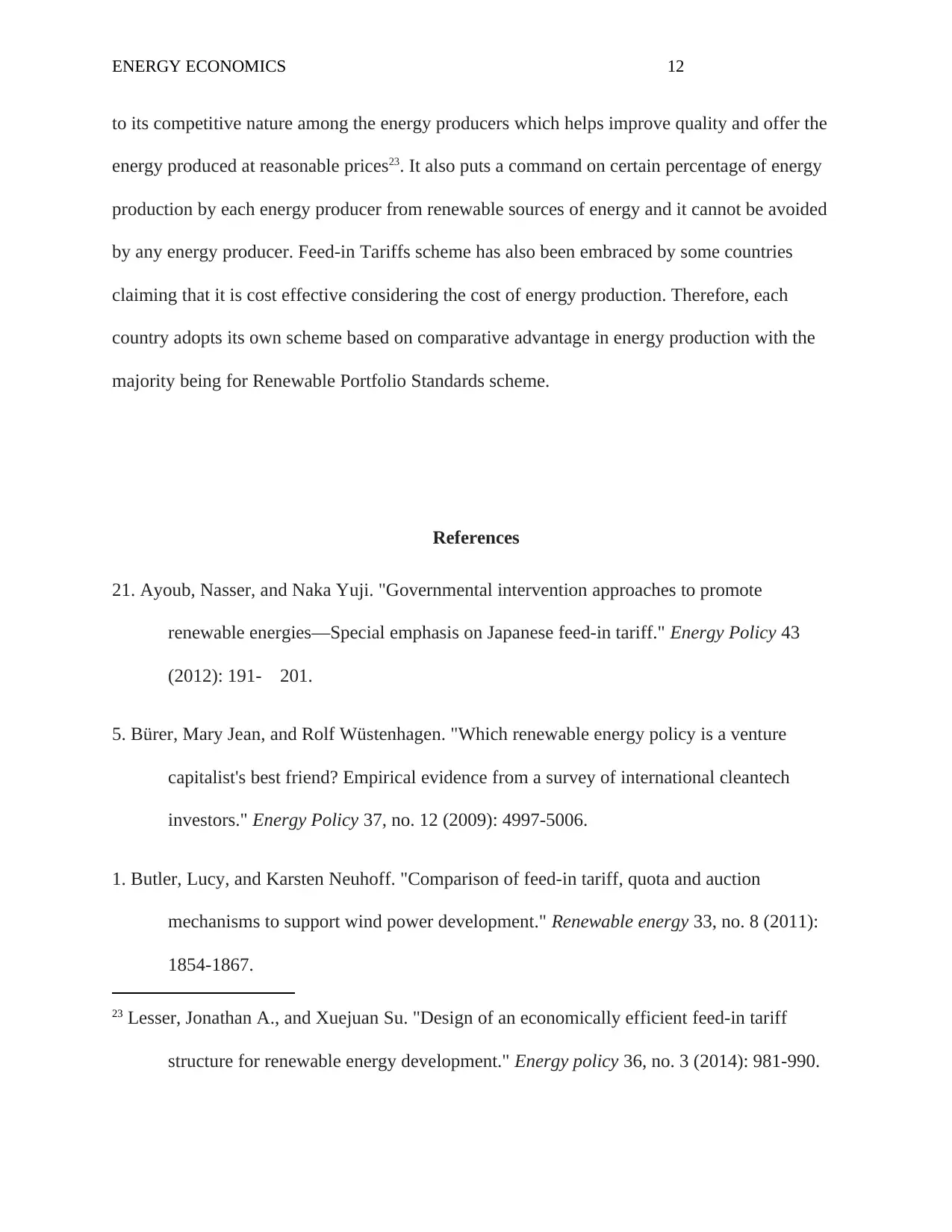
ENERGY ECONOMICS 12
to its competitive nature among the energy producers which helps improve quality and offer the
energy produced at reasonable prices23. It also puts a command on certain percentage of energy
production by each energy producer from renewable sources of energy and it cannot be avoided
by any energy producer. Feed-in Tariffs scheme has also been embraced by some countries
claiming that it is cost effective considering the cost of energy production. Therefore, each
country adopts its own scheme based on comparative advantage in energy production with the
majority being for Renewable Portfolio Standards scheme.
References
21. Ayoub, Nasser, and Naka Yuji. "Governmental intervention approaches to promote
renewable energies—Special emphasis on Japanese feed-in tariff." Energy Policy 43
(2012): 191- 201.
5. Bürer, Mary Jean, and Rolf Wüstenhagen. "Which renewable energy policy is a venture
capitalist's best friend? Empirical evidence from a survey of international cleantech
investors." Energy Policy 37, no. 12 (2009): 4997-5006.
1. Butler, Lucy, and Karsten Neuhoff. "Comparison of feed-in tariff, quota and auction
mechanisms to support wind power development." Renewable energy 33, no. 8 (2011):
1854-1867.
23 Lesser, Jonathan A., and Xuejuan Su. "Design of an economically efficient feed-in tariff
structure for renewable energy development." Energy policy 36, no. 3 (2014): 981-990.
to its competitive nature among the energy producers which helps improve quality and offer the
energy produced at reasonable prices23. It also puts a command on certain percentage of energy
production by each energy producer from renewable sources of energy and it cannot be avoided
by any energy producer. Feed-in Tariffs scheme has also been embraced by some countries
claiming that it is cost effective considering the cost of energy production. Therefore, each
country adopts its own scheme based on comparative advantage in energy production with the
majority being for Renewable Portfolio Standards scheme.
References
21. Ayoub, Nasser, and Naka Yuji. "Governmental intervention approaches to promote
renewable energies—Special emphasis on Japanese feed-in tariff." Energy Policy 43
(2012): 191- 201.
5. Bürer, Mary Jean, and Rolf Wüstenhagen. "Which renewable energy policy is a venture
capitalist's best friend? Empirical evidence from a survey of international cleantech
investors." Energy Policy 37, no. 12 (2009): 4997-5006.
1. Butler, Lucy, and Karsten Neuhoff. "Comparison of feed-in tariff, quota and auction
mechanisms to support wind power development." Renewable energy 33, no. 8 (2011):
1854-1867.
23 Lesser, Jonathan A., and Xuejuan Su. "Design of an economically efficient feed-in tariff
structure for renewable energy development." Energy policy 36, no. 3 (2014): 981-990.
⊘ This is a preview!⊘
Do you want full access?
Subscribe today to unlock all pages.

Trusted by 1+ million students worldwide
1 out of 15
Related Documents
Your All-in-One AI-Powered Toolkit for Academic Success.
+13062052269
info@desklib.com
Available 24*7 on WhatsApp / Email
![[object Object]](/_next/static/media/star-bottom.7253800d.svg)
Unlock your academic potential
Copyright © 2020–2025 A2Z Services. All Rights Reserved. Developed and managed by ZUCOL.




